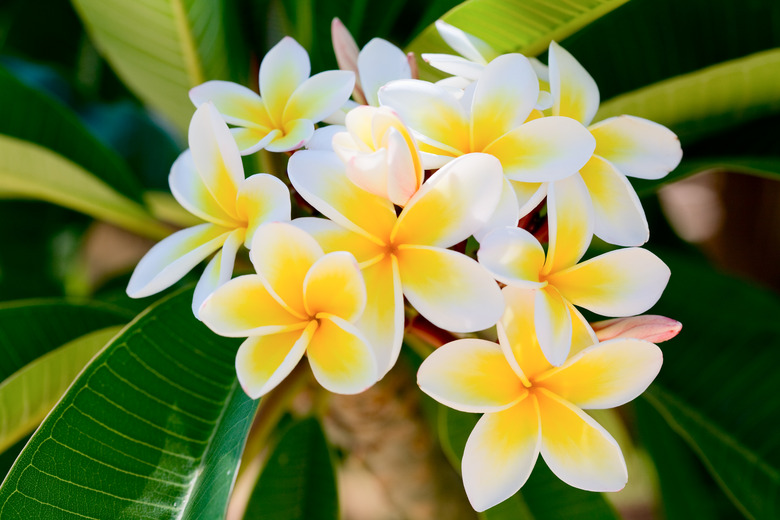Plumeria And Leaf Curl
We may receive a commission on purchases made from links.
Plumeria flowers (Plumeria spp., USDA zones 10-12) not only light up a landscape with their colorful blooms and vibrant smells, they are also an important flower for bouquets and flowering gifts. These flowering trees also produce one of the primary flowers, also called frangipani, used in making Hawaiian lei necklaces. So if you notice the normally beautiful flowers suffering from leaf curl, it's time to act.
There are two primary causes of curling leaves in plumeria: Aphids are pests that can cause plumeria leaves to curl, while plumeria rust is a fungal disease that can cause spots on the leaves in addition to causing them to curl. Both require quick action to avoid further damage.
Aphids on Plumeria
Aphids on Plumeria
Aphids are extremely small insects that can appear green, yellow, brown, red or black, depending on the type of aphid you see. These insects land and feed on the leaves of many plants, including plumeria. As they feed, they suck the nutrients and water right out of the leaves, causing curling, wilting, yellowing or browning as the leaves struggle to survive without much-needed nutrition.
As the aphids feed on the plants, they leave behind a sticky substance called honeydew. This excretion attracts mold diseases. Small populations will do little to no damage, but large aphid populations can cause defoliation or even kill an entire plant.
Plumeria Aphid Control
Plumeria Aphid Control
There are a large range of pesticides, insecticidal soaps and oils that can control aphids, since they are such a common pest for so many types of plants and flowers. The most important aspect of aphid control is identification. Check your plants for aphids at least twice per week. You'll see them as small dots moving on the surface of your leaves. When you catch them, spray the leaves with pesticide, oil or insecticidal soap.
Make sure you get the undersides of the leaves, where most of the aphids will reside. Repeat applications every two to three weeks until you can be sure that the infestation has passed.
Leaf Curl From Plumeria Rust
Leaf Curl From Plumeria Rust
Plumeria rust is a disease the fungus Coleosporium plumeriae causes. It's easy to identify by the small yellow or orange specks that appear on the leaves. The specks resemble rust on a metal pipe. These specks are actually pustules that contain spores of the fungus. When the pustules rupture, they release the spores and soon the whole plant, or many plants nearby, will be infected with the fungus.
Often, the pustules will only appear on the undersides of the leaves. The upper sides may only show small spots that don't rupture. Infected leaves will curl up, wilt and eventually fall from the plant.
Plumeria Rust Control
Plumeria Rust Control
Remove infected leaves from the plant with pruning shears and pick up any infected leaves that fall off the plant. Burn them or dispose of them far from the plant. These leaves can still spread the disease.
Plant plumerias with at least 15 feet of space between the plants to ensure good air circulation. Controlling all weeds will also increase air circulation. There are a number of fungicides that are approved to treat plumeria rust; be sure to read and follow all instructions regarding application.
